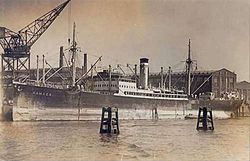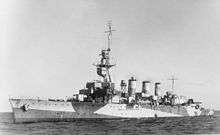Ramses (ship, 1926)
|
||||||||||||||||||||
|
||||||||||||||||||||
|
||||||||||||||||||||
|
||||||||||||||||||||
The Ramses was a combined ship that the Hamburg-American Packetfahrt-Actien-Gesellschaft (Hapag) received in 1926 through the takeover of the German steamship company Kosmos . The motor ship put into service in 1926 was the largest ship of the shipping company.
Ramses left Hamburg on July 1, 1939 for her last peace trip to Shanghai , where she arrived on August 25. When the world war broke out on September 3, the ship stayed there and did not sail to Kobe in Japan until March 29, 1941 . A first attempt to break the blockade to reach Europe was canceled.
The Ramses left Kobe in November 1942 in order to break the blockade and reach France, which was occupied by the Germans. After she had taken over a cargo of raw rubber in Batavia, she was stopped in the Indian Ocean by Allied warships and her crew 700 miles south of the Cocos Islands at position 23 ° 30 ′ 0 ″ S , 99 ° 21 ′ 0 ″ E, sunk to avoid capture.
history
The joint venture between DDG Kosmos and Hapag on the west coast of America ran out on January 4, 1921 without being renewed, especially as Hapag had no ships for this service. DDG Kosmos had already started service to the west coast of South America - now through the Panama Canal - in March 1920 with a chartered Chilean steamer. The first newly built ship, the Theben (IV, 2990 GRT), did not enter service until 1921. On June 22, 1921, the DDG Kosmos merged with the German-Australian Steamship Company (DADG) to form the German-Austral and Kosmos lines. The companies with completely different shipping areas continued to operate their own areas under the old shipping company flags, but merged their administrations and offset their profits and losses. They hoped that the merger would provide greater flexibility in order to be able to react to developments in the shipping areas. Eighteen new buildings were completed for the Australlinie by 1926, while only eleven newbuildings were ordered for the Kosmoslinie. For this purpose, she bought back eight former ships that had been delivered between 1921 and 1924.
The fourth Ramses of the Kosmos line was a single ship and with 7983 GRT the largest ship of the Kosmos line. She was the ninth post-war building on the line and her third motor ship. It was the last new building and the first new building on the line to have a passenger facility before the company merged with Hapag.
The first ship of the company to bear the name of the Pharaohs was the third steamer of the DDG Kosmos of 1608 GRT, completed at the Reiherstieg shipyard in 1876. The second Ramses of 3673 BRT was used from 1893 to 1911, which was then followed in 1912 by the third of 7125 BRT, which had to be delivered after the World War and which the NDL used as Pfalz (III) from 1922 to 1932 .
The shipyard of the new Ramses was the Flensburger Schiffbau-Gesellschaft (FSG), which had also built the name predecessor and a large number of other ships for the DDG Kosmos until the World War II. In Flensburg, the Karnak (7209 BRT) and the Menes (5609 BRT) were also two more single ships under construction, which were only delivered to Hapag after the line was taken over.
Use of the Ramses
The Ramses took before the union with the Hapag service to the West Coast of South America to Chile for the German-Austral and Cosmos lines. When Hapag decided in 1928 to increase its service to the US west coast, it was one of the ships that were used on this line before the new Los Angeles- class combination ships came into service. In the following years the Ramses was used on different lines.
On July 1, 1939, the Ramses left Hamburg for their last journey in peace to Shanghai , where they arrived on August 25. When the world war broke out on September 3, the ship remained in the Chinese port city and did not move to Kobe in Japan until March 29, 1941 .
War effort and further fate
The motor ship was supposed to be used as a blockade breaker to Europe and left Dairen on May 12th as the fifth blockade breaker. For the first time, the route through the Pacific and Cape Horn should be explored. Their cargo consisted of soy and raw rubber. On June 27th, the Ramses received the order to march back to Yokohama , where they arrived on July 30th and was unloaded again. She remained empty in Yokohama and was supposed to serve as a prisoner ship for Allied sailors from ships seized by German auxiliary cruisers.
In Japan, a self-submerging system was installed on the ship, which gave an evacuation time of eight minutes. In autumn 1942 the ship took over cargo again to be used as a blockade breaker. On October 10th, the journey began via Kobe to Balikpapan on Borneo , where they unloaded around 1000 tons of supplies for the Japanese garrison there. In Batavia she took over 4,000 tons of raw rubber and large quantities of quinine and unloaded everything that restricted the takeover of this cargo, which was essential for the war effort. On November 23, the Ramses left Batavia to travel to Bordeaux as the 24th blockade breaker from East Asia, of whom 17 had successfully broken the blockade so far.
The blockade breaker under the command of Captain Falke had primarily a civilian crew of Germans and a few Finns (a total of 60 men). There was also a small contingent of the Navy (1 lieutenant, 2 NCOs, 15 men) to operate the minor armament that had reached Japan with the blockade breaker Doggerbank . The armament consisted of two 20 mm cannons and four machine guns. At the stern there was still a large wooden dummy of a typical stern gun of an Allied freighter. The Ramses pretended to be the Norwegian Tai Yang , which was built in 1928 by the German works in Kiel. the ship was to meet auxiliary cruisers in the Indian Ocean, meetings with submarines were planned in the Atlantic and at the end of the voyage, aircraft were promised as protection. Ten Norwegian prisoners were also on board to serve as seamen.
Also on November 23, the old light cruiser HMAS Adelaide and the Dutch cruiser Jacob van Heemskerck left Fremantle to escort three freighters to Abadan that had loaded oil drilling equipment. After two days at sea, the tanker Goldmouth and the Australian corvettes Cessnock and Toowoomba joined the escort.
On the afternoon of November 28th, the lookout spotted a freighter turning off and calling 911 as Tai Yang . The Adelaide did not find the Norwegian ship in her records but correctly identified it as the German Ramses . After an hour-long chase by the two cruisers, the ship, which continued to fly the Norwegian flag, stopped and launched boats. Captain Falke evacuated the ship after the self-sinking system had triggered. The explosion on board and the simultaneous fogging of the Ramses caused the cruisers to open fire and the Ramses sank after a few minutes. Her wooden mock-up of a stern gun floated on the water for a while and was photographed by the Allied sailors.
While the Heemskerck was returning to the convoy, the Adelaide took the castaways on board and took them to Fremantle , where the 78 men of the crew became prisoners of war, while the ten Norwegian seamen were given their freedom.
literature
- Arnold Kludas: The History of German Passenger Shipping Vol. IV Destruction and Rebirth 1914 to 1930 , Writings of the German Maritime Museum, Volume 21
- Arnold Kludas: The History of German Passenger Shipping Vol. V An era comes to an end from 1930 to 1990 , Writings of the German Shipping Museum, Volume 22
- Reinhardt Schmelzkopf: German merchant shipping 1919–1939 . Verlag Gerhard Stalling, Oldenburg, ISBN 3 7979 1847 X .


